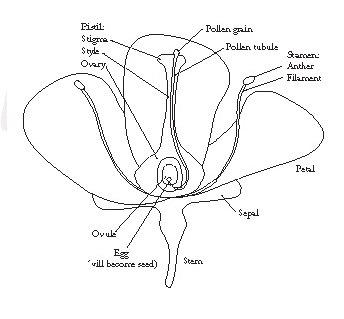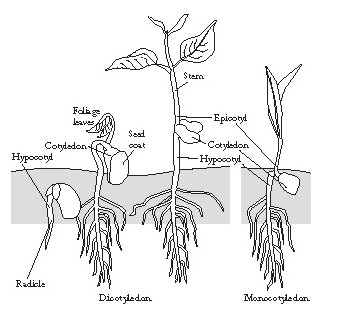Vascular Plants Described
Ascular plants encompass several divisions of plants and are collectively known as tracheophytes.
Tracheophytes are characterized primarily by the presence of a vascular system composed of two types of specialized tissue: xylem and phloem.
Xylem conducts water and minerals upward from the roots of a plant, while phloem transports sugars and other nutrients from the leaves to the other parts of the plant.
Both xylem and phloem are distributed throughout the plant.
The vascular tissue also serves as a means for mechanical support in the plant, so some tracheophytes (such as trees) can grow quite tall.
Seedless vascular plants (ferns)
In many plants, seeds are the structures from which the sporophyte generation emerges.
Seeds protect the embryonic plant during its early stages and store food.
Many plants do not form seeds in their life cycles, but they have flourished nevertheless.
Among the seedless vascular plants are the ferns, classified in the division Pteridophyta.
A mature fern produces spores by meiosis.
The spores are stored in cases called sori (the singular is sorus) on the underside of the fern leaf.
The leaf is a frond, and the sori resemble dots on the underside of the frond.
The fern plant is the sporophyte generation, and this generation dominates the life cycle.
After the spores are dispersed, they germinate into small heart-shaped haploid plants if they reach moist ground.
Each plant is called a prothallus and is a gametophyte, meaning it produces gametes for reproduction.
The antheridia and archegonia are found on the underside of the prothallus.
Sperm produced in the antheridia swim through moisture on the plant to the archegonia and fertilize the egg cells.
The resulting zygote grows within the protection of the archegonium and develops into a young sporophyte
. The sporophyte eventually grows out of the archegonium into a slender stalk. The stalk develops into a sporophyte, which, in its adult form, is the familiar fern plant.
Other divisions of the seedless vascular plants are the Psilophyta (the whisk ferns), the Lycophyta (the club mosses), and the Sphenophyta (the horsetails).
Vascular plants with unprotected seeds (gymnosperms)
Vascular plants having unprotected, or naked, seeds are known as gymnosperms.
Their seeds are not enclosed in female tissues and are therefore said to be naked.
There are four divisions of gymnosperms: Cycadophyta (Cycads), Ginkgophyta (Ginkgo), Gnetophyta (Gnetae), and Coniferophyta (Conifer).
Coniferophyta is the largest and most familiar division of the gymnosperms.
These plants are cone-bearers and are therefore called conifers.
Their seeds are borne on the surface of the female cone scales.
Members of this division include trees such as cedars, firs, spruces, pines, and giant redwoods.
The leaves are generally needle-shaped and contain vascular tissue.
The full-grown conifer (for example, a pine tree) is the sporophyte generation of the plant.
The sporophyte produces male and female cones on the same tree.
These cones produce spores that undergo meiosis and produce the male and female gametophytes.
Male gametophytes are the pollen grains, each consisting of four cells.
The male gametophyte produces sperm cells in the pollen grains.
The female gametophyte produces two or three egg cells that develop within protective structures called ovules.
In the spring, the male cone releases pollen, which is blown about by the wind.
Some pollen gets trapped on the female cone, where it germinates and forms a pollen tube that makes its way into the ovule.
A sperm cell then fertilizes the egg.
The zygote that is produced develops into an embryo within the ovule.
In time, the embryo matures into a seed.
Eventually, the seed falls from the cone and germinates, and the germinating embryo becomes a new pine tree.
The function of dispersal in gymnosperms is assumed by the seeds.
Growth of the embryo depends on food supplied from
The gametophyte generation is little more than a reproductive mechanism in the gymnosperms.
Both male and female gametophytes are tiny and entirely dependent on the parent sporophyte.
Vascular plants with protected seeds (angiosperms)
Angiosperms are the most developed and most complex vascular plants.
They are the flowering plants, of which more than 250,000 species have been identified.
Almost all vegetables, flowers, fruits, cereals, grains, grasses, and hardwood trees are angiosperms, the dominant life form on Earth today.
Angiosperm means “seed vessel,” a reference to the female tissues that enclose the seed.
The tissue is endosperm.
During embryonic development, the endosperm serves as a source of nourishment.
In many angiosperms, the endosperm develops into the fruit of the plant.
Thus, the protected seed is often found within a fruit.
The two most distinguishing features of angiosperms are the flower and the fruit.
The flower of an angiosperm (see Figure 19-1) consists of a ring of modified leaves called sepals that enclose and protect the growing flower bud.
In some species, the sepals are small and green, while in others they become colored and resemble the petals, the next ring.
Flower petals are colorful and are useful in attracting pollinating animals, especially insects.
Within the petals are the organs of reproduction: the male stamen and, at the center, the female pistil.

The Figure above Shows The flower of a plant and its structural features.
The stamen of a flower consists of a thin, stemlike filament and an anther, where haploid pollen grains are produced.
Each pollen grain is a male gametophyte containing sperm cells.
The pistil consists of a sticky stigma; a style, which is a narrow stalk connecting the stigma to the top of the ovary; and the ovary, which is where the ovules are enclosed.
In each ovule, a single mother cell divides to produce four cells, one of which will develop into a female gametophyte.
The female gametophyte is a sac in which there are eight cells, one of which is the egg cell.
In the angiosperm life cycle, a pollen grain lands on the stigma and produces a pollen tube that grows from the pollen grain down through the style, penetrating the ovary to reach the ovule.
One of the sperm cells in the pollen tube fertilizes the egg cell in the ovary to produce a diploid zygote.
The zygote becomes the new plant embryo.
Another sperm cell fuses with two other cells in the female gametophyte to produce a triploid (three sets of chromosomes) endosperm nucleus, which develops into the endosperm that will feed the growing embryo.
The ovule becomes the seed in which the embryo develops, and the ovary ripens into a fruit.
During plant development, the cells become more specialized.
In angiosperms, the embryo remains dormant for a while.
When the seed germinates, the embryo grows further.
Germination may depend on the availability of oxygen, a suitable temperature, or adequate light.
Germination requires the availability of stored food within the seed.
In plants called monocots (monocotyledon plants), most of the food is stored in the endosperm in one seed leaf called a cotyledon.
In dicots (dicotyledon plants), most of the food is stored in endosperm in two cotyledons.
Among the monocots are grasses, orchids, irises, and lilies.
Dicots have two seed leaves (cotyledons) that provide nutrients for the plants as they grow for the seed.
Monocots have a single cotyledon.
Monocots usually have parallel leaf veins and flower parts occurring in threes.
Dicots, in contrast, usually have netlike leaf veins and flower parts in fours or fives.
Most of the flowering plants are dicots.

The Figure above Shows Growth of monocotyledon (monocot) and dicotyledon (dicot) plants.
Other parts of the young plant are illustrated.
Scholarship 2026/27
Current Scholarships 2026/2027 - Fully Funded
Full Undergraduate Scholarships 2026 - 2027
Fully Funded Masters Scholarships 2026 - 27
PhD Scholarships for International Students - Fully Funded!
Funding Opportunities for Journalists 2026/2027
Funding for Entrepreneurs 2026/2027
***
